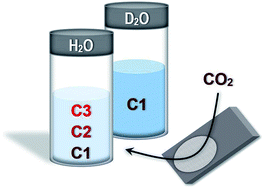Mechanistic insights into C2 and C3 product generation using Ni3Al and Ni3Ga electrocatalysts for CO2 reduction†
Abstract
Thin films of Ni3Al and Ni3Ga on carbon solid supports have been shown to generate multi-carbon products in electrochemical CO2 reduction, an activity profile that, until recently, was ascribed exclusively to Cu-based catalysts. This catalytic behavior has introduced questions regarding the role of each metal, as well as other system components, during CO2 reduction. Here, the significance of electrode structure and solid support choice in determining higher- versus lower-order reduction products is explored, and the commonly invoked Fischer–Tropsch-type mechanism of CO2 reduction to multi-carbon products is indirectly probed. Electrochemical studies of both intermetallic and non-mixed Ni–Group 13 catalyst films suggest that intermetallic character is required to achieve C2 and C3 products irrespective of carbon support choice, negating the possibility of separate metal sites performing distinct yet complementary roles in CO2 reduction. Furthermore, Ni3Al and Ni3Ga were shown to be incapable of generating higher-order reduction products in D2O, suggesting a departure from accepted mechanisms for CO2 reduction on Cu. Additional routes to multi-carbon products may therefore be accessible when developing intermetallic catalysts for CO2 electroreduction.

- This article is part of the themed collection: Artificial photosynthesis


 Please wait while we load your content...
Please wait while we load your content...
